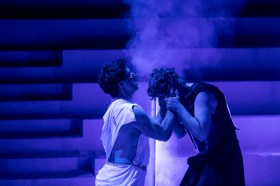Photo by Jamie Williams
The wonderful experimental choreography of Sasha Waltz in Dido & Aeneas elevates an otherwise average production.
Waltz’s choreography boasts an impressively wide range, encompassing traditional ballet, contemporary dance, folk dance styles including tango, tap and sequences that have clearly borrowed from martial arts forms such as capoeira. The over-arching aesthetic is one of experimentalism.Curious, then, that Waltz tends to choose operas which could hardly be described as experimental, as the material for her reformulations. In the past she has worked with operas Medea and Romeo & Juliet. Perhaps it is the desire to be constricted to a certain degree by the straitjacket of a form, and to inflame the imagination in the process.
In any case, Waltz’s direction here is highly imaginative – from sequences of bodies writhing in unison across the stage, to acrobatic scenes of trapeze-like dancers doing battle in flight, to more tender scenes of romantic ballet and contemporary dance. The use of the space is highly innovative, with a giant, portable water tank wheeled in at the start for the opening scene, serving as the watering hole for the frolicking nymphs.
There were really only a couple of instances where the choreography felt repetitive and staid. These came in the solo dancer moments, which without musical accompaniment felt rather long and lacking in dynamism. However, these few small lapses testify to the comparative strength of a piece which is almost two hours in length.
Of the narrative there is not much to tell which is not already known in the popular imagination – the unrequited love between the Queen of Carthage Dido and the Trojan War survivor and Roman hero Aeneas. The baroque opera composed by Henry Purcell in the late seventeenth century, as well as being this story of classical myth, serves as a political allegory for its time, with the prologue referring to the joy of marriage between two monarchs – William and Mary. Some interpreters suggest the characters of the Sorceress and the witches, which were introduced by the librettist Nahum Tate, symbolise the corrupting powers of the Roman Catholic church.
In any case, while the music is an interesting addition to the baroque canon, the same cannot be said for the libretto, which at some points reads like a nursery rhyme and at others sacrifices meaning for the sake of weak literary devices. It’s a shame Purcell could not have found a wordsmith to match his own musical talents, and no surprise that Waltz has decided to translate the libretto into dance rather than retain the poetry. Credit to the musicians and singers from Sasha Waltz & Guests and the Akademie für Alte Musik Berlin, who presented some of the opera’s baroque beauty.
Rating: 4 stars out of 5
Dido & Aeneas
Music: Henry Purcell
Libretto: Nahum Tate
Based on: Book VI of Virgil’s Aeneid
Choreography: Sasha Waltz
Performed by: Sasha Waltz & Guests Company, music by Akademie für Alte Musik Berlin.
Sydney Lyric Theatre
www.sydneyfestival.org.au
16 – 21 January






